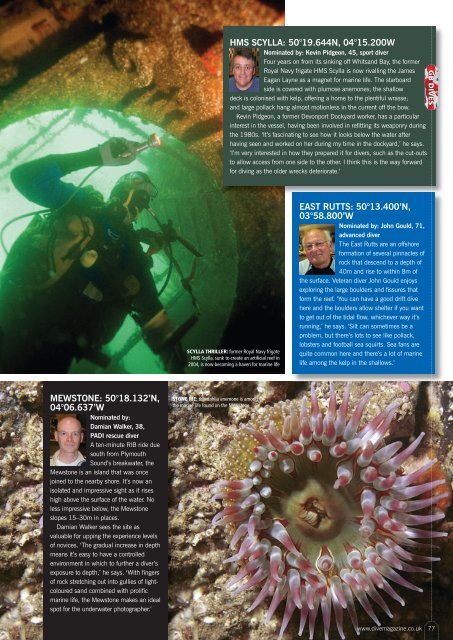the insider's guide to plymouth's greatest dives - Plymouth Sound ...
the insider's guide to plymouth's greatest dives - Plymouth Sound ...
the insider's guide to plymouth's greatest dives - Plymouth Sound ...
You also want an ePaper? Increase the reach of your titles
YUMPU automatically turns print PDFs into web optimized ePapers that Google loves.
MEWSTONE: 50°18.132’N,<br />
04°06.637’W<br />
Nominated by:<br />
Damian Walker, 38,<br />
PADI rescue diver<br />
A ten-minute RIB ride due<br />
south from <strong>Plymouth</strong><br />
<strong>Sound</strong>’s breakwater, <strong>the</strong><br />
Mews<strong>to</strong>ne is an island that was once<br />
joined <strong>to</strong> <strong>the</strong> nearby shore. It’s now an<br />
isolated and impressive sight as it rises<br />
high above <strong>the</strong> surface of <strong>the</strong> water. No<br />
less impressive below, <strong>the</strong> Mews<strong>to</strong>ne<br />
slopes 15–30m in places.<br />
Damian Walker sees <strong>the</strong> site as<br />
valuable for upping <strong>the</strong> experience levels<br />
of novices. ‘The gradual increase in depth<br />
means it’s easy <strong>to</strong> have a controlled<br />
environment in which <strong>to</strong> fur<strong>the</strong>r a diver’s<br />
exposure <strong>to</strong> depth,’ he says. ‘With fingers<br />
of rock stretching out in<strong>to</strong> gullies of lightcoloured<br />
sand combined with prolific<br />
marine life, <strong>the</strong> Mews<strong>to</strong>ne makes an ideal<br />
spot for <strong>the</strong> underwater pho<strong>to</strong>grapher.’<br />
HMS SCYLLA: 50°19.644N, 04°15.200W<br />
Nominated by: Kevin Pidgeon, 45, sport diver<br />
Four years on from its sinking off Whitsand Bay, <strong>the</strong> former<br />
Royal Navy frigate HMS Scylla is now rivalling <strong>the</strong> James<br />
Eagan Layne as a magnet for marine life. The starboard<br />
side is covered with plumose anemones; <strong>the</strong> shallow<br />
deck is colonised with kelp, offering a home <strong>to</strong> <strong>the</strong> plentiful wrasse;<br />
and large pollack hang almost motionless in <strong>the</strong> current off <strong>the</strong> bow.<br />
Kevin Pidgeon, a former Devonport Dockyard worker, has a particular<br />
interest in <strong>the</strong> vessel, having been involved in refitting its weaponry during<br />
<strong>the</strong> 1980s. ‘It’s fascinating <strong>to</strong> see how it looks below <strong>the</strong> water after<br />
having seen and worked on her during my time in <strong>the</strong> dockyard,’ he says.<br />
‘I’m very interested in how <strong>the</strong>y prepared it for divers, such as <strong>the</strong> cut-outs<br />
<strong>to</strong> allow access from one side <strong>to</strong> <strong>the</strong> o<strong>the</strong>r. I think this is <strong>the</strong> way forward<br />
for diving as <strong>the</strong> older wrecks deteriorate.’<br />
SCYLLA THRILLER: former Royal Navy frigate<br />
HMS Scylla, sunk <strong>to</strong> create an artificial reef in<br />
2004, is now becoming a haven for marine life<br />
STONE ME: this dahlia anemone is among<br />
<strong>the</strong> marine life found on <strong>the</strong> Mews<strong>to</strong>ne<br />
EAST RUTTS: 50°13.400’N,<br />
03°58.800’W<br />
Nominated by: John Gould, 71,<br />
advanced diver<br />
The East Rutts are an offshore<br />
formation of several pinnacles of<br />
rock that descend <strong>to</strong> a depth of<br />
40m and rise <strong>to</strong> within 8m of<br />
<strong>the</strong> surface. Veteran diver John Gould enjoys<br />
exploring <strong>the</strong> large boulders and fissures that<br />
form <strong>the</strong> reef. ‘You can have a good drift dive<br />
here and <strong>the</strong> boulders allow shelter if you want<br />
<strong>to</strong> get out of <strong>the</strong> tidal flow, whichever way it’s<br />
running,’ he says. ‘Silt can sometimes be a<br />
problem, but <strong>the</strong>re’s lots <strong>to</strong> see like pollack,<br />
lobsters and football sea squirts. Sea fans are<br />
quite common here and <strong>the</strong>re’s a lot of marine<br />
life among <strong>the</strong> kelp in <strong>the</strong> shallows.’<br />
GB DIVES<br />
www.divemagazine.co.uk 77


